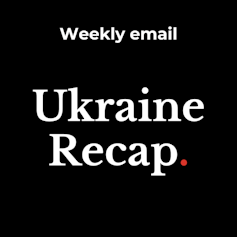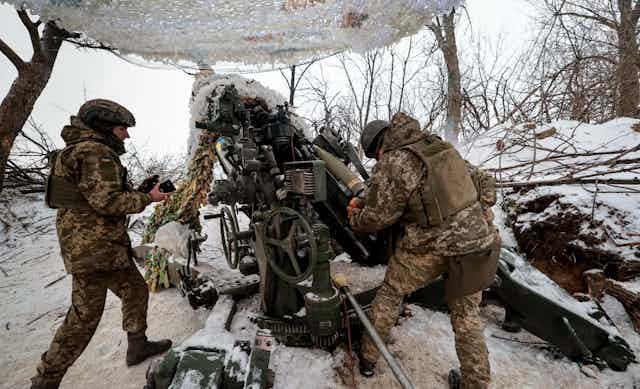As you’d expect, Ukraine’s president, Volodymyr Zelensky, has been working the room at the World Economic Forum in Davos this week. After a disappointing end to 2023 on the battlefield, with signs of battle fatigue among some of his key allies, Zelensky will be aware of the need to press his country’s case to so many world leaders. An estimated 60 heads of state and government are thought to have made the trip to Switzerland for this global forum, more than in previous years.
It was preceded by a meeting of more than 90 national security advisers, for whom a key agenda item was coming up with a viable peace plan for the conflict in Ukraine. Zelensky will also have been aware of the way the focus of global attention has moved to events in the Middle East, so a chance to get in front of his allies at this point is like gold dust.
There were positive noises from Nato’s secretary general, Jens Stoltenberg, as well as US national security adviser Jake Sullivan, who emphasised Ukraine’s success in winning back more than half the territory Russia had occupied since February 2022, as well as – for now at least – breaking Russia’s blockade in the Black Sea to allow grain ships in and out of its ports. Sullivan also praised the way Ukraine had managed to establish a viable defence industrial base.
The fruits of this were demonstrated this week when a hybrid “FrankenSAM” air defence system, which merges advanced western missiles with a Soviet-era launcher, successfully shot down an Iranian-made Shahed drone. Ukraine is also reported to be ramping up domestic production of Nato-compatible ammunition.
All of which will be doubly important if, as is now being widely reported, Russia is preparing to launch a major new ground offensive in the coming weeks. As Stefan Wolff and Tetyana Malyarenko report, Russian forces have intensified their attacks on various sectors along the frontline in Ukraine, and have made some small territorial gains in the past week or so.

Wolff and Malyarenko, international security experts from the universities of Birmingham and Odesa respectively, highlight the extent to which shortages of weapons and ammunition are making it increasingly difficult for Ukraine to hold the line, let alone deliver the sort of battlefield breakthroughs that Kyiv – and its western allies – so desperately need.
Both sides are also short on manpower. Zelensky has said he wants to be able to field an additional 500,000 troops this year, and has introduced more stringent measures to clamp down on draft dodging.
Meanwhile Russia, which can currently rely on a steady supply of 30,000 extra troops a month, has also signalled it’s intentions to boost troop numbers by switching off the heating at many of its prisons – the better to encourage criminals to swap their jail sentences for a spell at the frontline.
Read more: Ukraine war: talk of Russian spring offensive raises fears that Kyiv is ill-prepared to face it

Since Vladimir Putin sent his war machine into Ukraine on February 24 2022, The Conversation has called upon some of the leading experts in international security, geopolitics and military tactics to help our readers understand the big issues. You can also subscribe to our fortnightly recap of expert analysis of the conflict in Ukraine.
War in the air
Given all this, it’s easy to understand why Kyiv raced to announce what it claims as a major coup in the air war. The reported (though not yet confirmed) destruction of a Russian A-50 radar early-warning plane and an Ilyushin Il-22M airborne command post on January 14 will seriously degrade Russia’s ability to provide real-time aerial intelligence to its troops on the ground, according to Matthew Powell, a specialist in aerial warfare at the University of Portsmouth.
Powell writes here that Russia is reported to only have three A-50s in service. They cost an estimated US$330 million (£260 million) to replace. But it isn’t so much the expense of replacing the aircraft that will hamstring Russia. They are a very specialised piece of equipment and the 15-person crew takes years to train – so replacing that capability will be very difficult.
It’s been reported that the two aircraft were caught by a Patriot ground-based air defence system, of the kind provided by the US late in 2022. If correct, this will give Joe Biden’s administration a chance to parade the effectiveness of US military aid to recalcitrant members of Congress who continue to block the president’s US$110 million aid package for Ukraine.
Read more: Ukraine war: why Kyiv is cock-a-hoop about shooting down two Russian aircraft
Death to Spies!
Anyone who, like me, grew up on James Bond will be familiar with the sinister Soviet counter-espionage organisation, Smersh. Who can forget the end of From Russia With Love, when Bond has to fight for his life against the dastardly Rosa Klebb and her fiendish poison-tipped shoes?
In reality, Smersh was established by Josef Stalin during the second world war to trap German spies. The name Smersh (a blend of Russian words Smert’ Shpionam which translates into English as “death to spies”) was supposedly coined by Stalin himself.
As you’d expect, Smersh did a fair bit of spying on ordinary Russians, too. In all, an estimated 30,000 German “spies” within the Red Army and at least 594,000 other Soviet soldiers were arrested, most of whom would have been either executed or consigned to the gulags.

Mothballed in 1946, Smersh has now reportedly been reactivated by Vladimir Putin to root out any signs of dissent in Crimea or behind Russia’s lines in Ukraine. Marina Miron and Rod Thornton, intelligence and security experts at King’s College London, trace the organisation’s history and conclude from its revival that Putin considers the possibility of subversion and dissidence – or even plain old opposition to the war – to be a sufficient problem to warrant such a sinister move.
As they conclude, the resurrection of the name Smersh is “clearly the reaction of an increasingly oppressive state. Russian authorities, it can only be assumed, want to invoke fear again. This does not bode well for the Russian people.”
Read more: Smersh: why Putin has reinstated Stalin's notorious and much-feared anti-spy unit
… and oppression for LGBTQ+ people
Meanwhile Russia has moved to make life more difficult for another of Putin’s pet hates. In December 2023, a judgment of Russia’s supreme court banned what it referred to as the “LGBTQ+ movement” as an “extremist organisation”.
This effectively means that even identifying as LGBTQ+ in Russia is dangerous as it will lay a person open to charges of supporting extremism, writes Sergey Katsuba, whose research at University College Dublin focuses on Russia’s growing authoritarianism and the persecution of sexual minorities in the Putin era.
Katsuba traces a 30-year cycle from 1993 – when, under pressure from the Council of Europe, Boris Yeltsin’s government decriminalised consensual sex between men – to December’s supreme court decision. He finds a strong correlation between Putin’s increasing authoritarianism and the demonisation of sexual minorities in Russia.
Read more: 30 years of LGBTQ+ history in Russia: from decriminalisation in 1993 to 'extremist' status in 2023
Time to dig your bunker?
There have recently been warnings emerging from a number sources, including the governments of Germany, Sweden and Estonia, that Putin is actively planning to extend his “special military operation” into a confrontation with Nato – something that everyone fears could quickly spiral out of control.
Meanwhile, as anyone following our coverage of the conflict in the Middle East will know, fears that the Gaza war could escalate into a regional conflagration pulling in Iran, Saudi Arabia and the US mount daily. And that’s before we factor in China’s increasingly aggressive rhetoric about Taiwan, and North Korea’s bloodcurdling threats against the South.
If you feel as if all the wars in the world are about to join hands, you would not be alone. Mark Lacy of Lancaster University, who is presently writing a book on the future of war, considers what is often referred to as the “threat horizon”.
He believes the situation is made more complicated by the changing nature of conflict. Economic warfare, cyberwar and the increasing influence of artificial intelligence in the way conflicts are waged mean that the next major war will probably look completely different to what we might expect, yet be equally as devastating. So, while you may not feel the need to start digging your bunker quite yet, it may be best to keep a spade handy just in case.
Ukraine Recap is available as a fortnightly email newsletter. Click here to get our recaps directly in your inbox.

